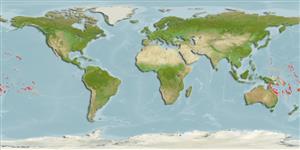>
Acanthuriformes (Surgeonfishes) >
Acanthuridae (Surgeonfishes, tangs, unicornfishes) > Acanthurinae
Etymology: Acanthurus: Greek, akantha = thorn + Greek, oura = tail (Ref. 45335).
Eponymy: Achilles was the mythical Greek hero of the Trojan War. His only vulnerable spot was his heel (hence ‘Achilles’ heel’). The tang has a (roughly) heel-like mark on its body. (Ref. 128868), visit book page.
More on author: Shaw.
Issue
Distribution to be checked.
Environment: milieu / climate zone / depth range / distribution range
Ecologia
marino associati a barriera corallina; distribuzione batimetrica 0 - 10 m (Ref. 27115), usually 0 - 4 m (Ref. 9710). Tropical; 28°N - 26°S, 143°E - 109°W
Western Pacific: oceanic islands of Oceania to the Hawaiian and Pitcairn islands. Also known from Wake, Marcus, and Mariana islands. Eastern Central Pacific: southern tip of Baja California, Mexico (Ref. 9267) and other offshore islands.
Size / Peso / Age
Maturity: Lm ? range ? - ? cm
Max length : 24.0 cm TL maschio/sesso non determinato; (Ref. 9710)
Spine dorsali (totale) : 9; Raggi dorsali molli (totale) : 29 - 33; Spine anali: 3; Raggi anali molli: 26 - 29. Dark brown, nearly black in color. Erectile spine (sharp and forward-pointing) on each side of caudal peduncle which folds down into a groove. Mouth small, snout noticeably extended. Light blue ring around chin and presence of spot of same color on gill cover at angle of gill opening. Dorsal fin with soft part having longer base than spinous part. Juveniles lack the large orange spot on caudal area.
Occurs in clear seaward reefs, usually in groups (Ref. 9710). Benthopelagic (Ref. 58302). Feeds on filamentous and small fleshy algae (Ref. 9267). Monogamous (Ref. 52884). Spine in caudal peduncle may be venomous. Size of metamorphosis from postlarva stage to juvenile is 6 cm (Ref. 9267). This species sometimes hybridizes with A. nigricans (Ref. 9808).
Life cycle and mating behavior
Maturità | Riproduzione | Deposizione | Uova | Fecundity | Larve
Monogamous mating is observed as both facultative and social (Ref. 52884).
Randall, J.E., 1956. A revision of the surgeonfish genus Acanthurus. Pac. Sci. 10(2):159-235. (Ref. 1920)
IUCN Red List Status (Ref. 130435: Version 2024-1)
Threat to humans
Traumatogenic (Ref. 4690)
Human uses
Pesca: commerciale; Acquario: Commerciale
Strumenti
Special reports
Download XML
Fonti Internet
Estimates based on models
Preferred temperature (Ref.
123201): 25.8 - 28.3, mean 27.4 °C (based on 404 cells).
Phylogenetic diversity index (Ref.
82804): PD
50 = 0.5000 [Uniqueness, from 0.5 = low to 2.0 = high].
Bayesian length-weight: a=0.01995 (0.00906 - 0.04395), b=3.01 (2.83 - 3.19), in cm total length, based on all LWR estimates for this body shape (Ref.
93245).
Trophic level (Ref.
69278): 2.0 ±0.00 se; based on food items.
Resilienza (Ref.
120179): Alto, tempo minimo di raddoppiamento della popolazione meno di 15 mesi (Preliminary K or Fecundity.).
Fishing Vulnerability (Ref.
59153): Low vulnerability (14 of 100).
Nutrients (Ref.
124155): Calcium = 77.7 [33.7, 236.7] mg/100g; Iron = 0.837 [0.317, 2.103] mg/100g; Protein = 18.2 [16.9, 19.4] %; Omega3 = 0.0938 [, ] g/100g; Selenium = 13 [4, 39] μg/100g; VitaminA = 45.8 [10.8, 181.2] μg/100g; Zinc = 3.17 [0.99, 6.04] mg/100g (wet weight);
